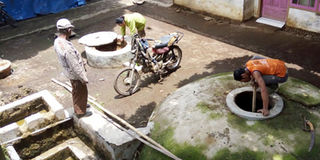TOFU power to light homes

What you need to know:
- Handy. In Central Java, villagers are making (and using) biogas from tofu waste.
Farm solutions. In Central Java, villagers are making (and using) biogas from tofu waste.
White smoke billows from the kitchen at the house of a 52-year old woman, Tumirah, a tofu maker in Kalisari village, Banyumas, in Central Java. Burning wood boils the soybean stew in a large stove called a kawah, or crater, by the locals.
In one day, Tumirah can process 80 kg of soybeans to make yellow tofu, which also produces 30 buckets—or 600 liters—of foamy, smelly wastewater. The wastewater was formerly discarded, but now it is piped to a digester container about 300 meters from Tumirah’s house and processed into biogas. The biogas is then channeled through a smaller pipe to Tumirah’s house to light the stove for cooking her daily necessities.
Tumirah said her family has been using biogas to cook for three years, as opposed to liquid petroleum gas (LPG). “The flames are good and I prefer using biogas rather than an LPG canister for fear of explosions.” She also claimed it helped her save money, since she only needs to drain wastewater from her tofu production and pay Rp 15,000 per month to the biogas installer for pipeline maintenance and biogas management.
More than food
According to the chief of the Kalisari village, Aziz Masruri, the village has been known as a tofu-producing center since the 1970s. The tofu from the village is chewy and solid, but not sour.
In the village, which has a population of 4,671 people, there are 250 tofu makers. On average each tofu maker processes 50 kg of soybean per day and can produce 1,500 pieces of tofu. The liquid waste can reach seven liters for every kilogram of soybeans.
Rifda Naufalin, a lecturer in food sciences and technology at the University of General Soedirman’s Faculty of Agriculture, said tofu liquid waste contains vegetable protein, vinegar and organic acid. It has a slightly acidic pH content. “If the organic material is fermented, it can produce methane gas that can be used for cooking,” she said.
Naufalin said untreated liquid wastewater has a pH of 4-5, which can kill fish and cause rice crop failure. The organic materials, if not managed properly, will decay and produce ammonia gas that emits a bad smell.
In the past, the village’s tofu makers dumped the wastewater into the river, causing serious pollution and turning the water dense, smelly and foamy. “It used to be a dirty river. In addition to being unsightly, the smell was so strong,” Masruri said. In one day, about 70,000 liters of liquid waste were dumped into the river.
Interventions
The pollution problem was resolved by the construction of five wastewater treatment plants, which were built in phases between 2010 and 2014 with the help of a number of institutions including the Research and Technology Ministry, the Central Java Environment Agency, the government of Banyumas Regency and the local community. “Now, 142 of the village’s 250 tofu makers pipe their wastewater to the digester containers, which generate biogas for 210 houses,” Masruri said.
According to Naufalin, the sustainability of biogas production must be maintained by training and improving the skills of residents to manage wastewater treatment plants. Currently, the wastewater treatment plants are managed by five groups from Biolita I to Biolita V.
Masruri acknowledges there is still weak coordination and management among group members so the maintenance and utilization of biogas is not optimal. “For example, in Biolita III many pipes have been damaged and broken. The village has allocated Rp 8 million for repairs,” he said.
The same view was shared by Taryo, 54, a tofu maker of Biolita I. Taryo, who has processed 75 kg of soybeans a day for the past two years, is no longer able to use biogas because the stove and pipes are damaged. “We do not use biogas for cooking. The sewer pipes to the digester container were blocked two months ago,” he said.
Wardoyo, 42, the manager of the Biolita IV wastewater treatment plant, admitted that problems often occurred due to the large amounts of dirt, wood and leaves in the wastewater container.
“Garbage must be removed because it can clog pipes and waste containers.”
Nonetheless, many villagers continue using the biogas for their daily needs. Tumirah, the tofu maker, demonstrated how, by opening the gas line connected to the stove, turning on a switch and lighting a match above the stove. A blue flame with a steady blaze immediately appeared.
“I sometimes fry some meatballs for lunch with the biogas stove,” she said. “In addition to cooking side dishes, it can also be used to cook vegetables and boil water.”




